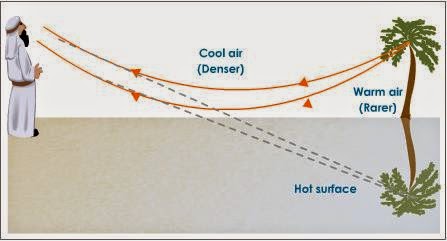MIRAGE
A mirage is a naturally occurring optical phenomenon in which light rays are bent to produce a displaced image of distant objects or the sky. The word comes to English via the French mirage, from the Latin mirari, meaning "to look at, to wonder at". This is the same root as for "mirror" and "to admire".
In contrast to a hallucination, a mirage is a real optical phenomenon that can be captured on camera, since light rays are actually refracted to form the false image at the observer's location. What the image appears to represent, however, is determined by the interpretive faculties of the human mind. For example, inferior images on land are very easily mistaken for the reflections from a small body of water.
Mirages can be categorized as "inferior" (meaning lower), "superior" (meaning higher) and "Fata Morgana", one kind of superior mirage consisting of a series of unusually elaborate, vertically stacked images, which form one rapidly changing mirage.
Cause
Cold air is denser than warm air and, therefore, has a greater refractive index. As light travels at a shallow angle along a boundary between air of different temperature, the light rays bend towards the colder air. If the air near the ground is warmer than that higher up, the light ray bends upward, effectively being totally reflected just above the ground.
Once the rays reach the viewer’s eye, the visual cortex interprets it as if it traces back along a perfectly straight "line of sight". However, this line is at a tangent to the path the ray takes at the point it reaches the eye. The result is that an "inferior image" of the sky above appears on the ground. The viewer may incorrectly interpret this sight as water that is reflecting the sky, which is, to the brain, a more reasonable and common occurrence.
In the case where the air near the ground is cooler than that higher up, the light rays curve downward, producing a "superior image".
The "resting" state of the Earth's atmosphere has a vertical gradient of about -1° Celsius per 100 metres of altitude. (The value is negative because it gets colder as altitude increases.) For a mirage to happen, the temperature gradient has to be much greater than that. According to Minnaert,[1] the magnitude of the gradient needs to be at least 2°C per metre, and the mirage does not get strong until the magnitude reaches 4° or 5°C per metre. These conditions do occur with strong heating at ground level, for example when the sun has been shining on sand or asphalt, commonly generating an inferior image.


No comments:
Post a Comment